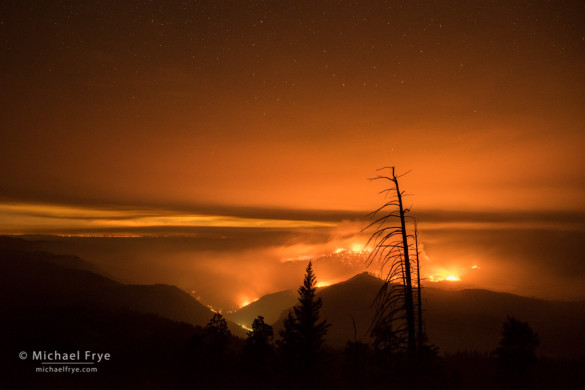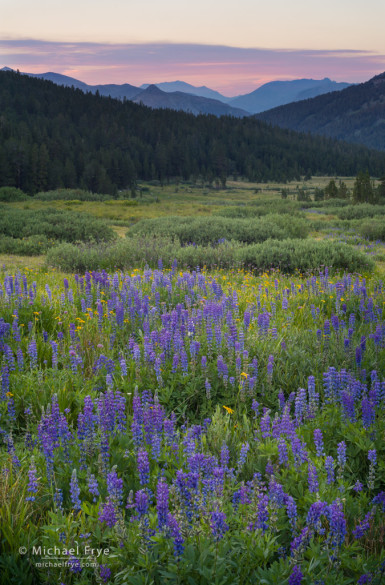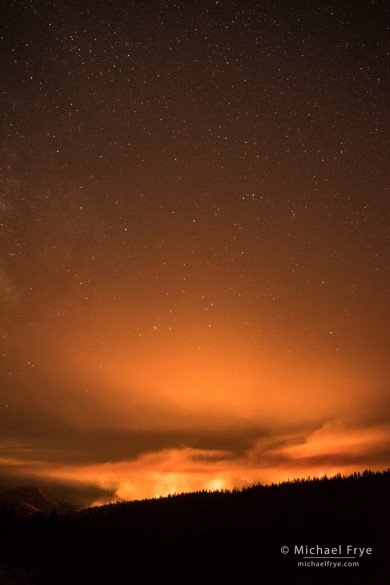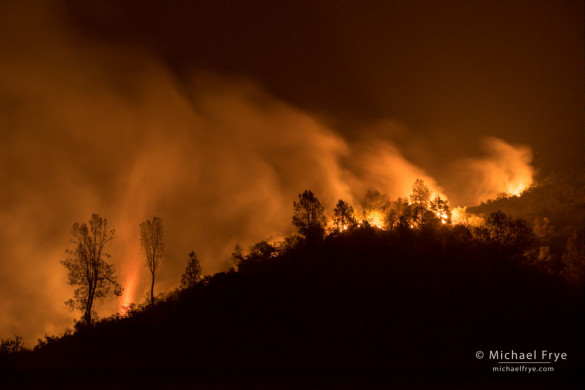We had no inkling that anything was wrong until we reached Crane Flat, where a ranger told us the road down to Yosemite Valley was closed.
Claudia had said that the wildflowers were nice in the Yosemite high country, so we decided to go for a hike up there yesterday afternoon. We drove through El Portal sometime between 3:00 and 3:30 p.m. and continued up the Big Oak Flat Road to Crane Flat. Everything seemed normal. Near Yosemite Creek we passed the Dark Hole Fire. This is a lightning-caused fire that the park service is letting burn, but it looked pretty active yesterday afternoon, with a big smoke plume.
We continued on past Tuolumne Meadows, started our hike, and found some gorgeous wildflowers (you can see a photograph below). Then we returned to the car, and started home at about 10 p.m. Near Yosemite Creek I decided to stop and photograph the Dark Hole Fire (below), then we continued west back to Crane Flat, where we saw a ranger vehicle blocking the road down to Yosemite Valley.
We were surprised that the road was closed, since we’d just driven up it a few hours earlier. The ranger let us through, since we had a park sticker, but he told us there was no stopping, and to watch out for fire crews. Fire crews? We knew these crews weren’t for the Dark Hole Fire, as that was miles away, and still pretty small. What had happened?
We found out as we passed the little community of Foresta, on the western edge of the park. There were flames all around Foresta, and up on the ridges to the west. It looked like at least 1,000 acres had burned.
We continued down Highway 140 (which was still open). As we came around a bend in the canyon, we could see an orange glow over El Portal. We feared that the whole town had burned, but when we got there the town looked intact, though there were big flames on the hillside just above it.
We were in shock. How did this all happen so quickly? We had passed through El Portal that afternoon, and didn’t notice anything unusual. We returned to a surreal universe filled with flames and anxiety.
Claudia and I decided to drive up to Highway 41 to see if we could find a an overview of the fire. We ended up along the Glacier Point Road, where I made the photograph at the top of this post. El Portal can be seen between the trees, near the bottom of the canyon left of center. Foresta is just to the right of the dead snag. That snag was burned in the 1990 Steamboat Fire, while the other, living trees in the foreground have grown up since then, so they’re 23 or 24 years old. We remember that fire well, since our son Kevin was born two weeks after it started. He’s the same age as those young trees.
We later learned that yesterday’s fire started in El Portal around 3:15 p.m. – about the time we first drove by. Several residents have reported that the fire was caused by a short in a power line, though these reports are unconfirmed. The fire then spread quickly up the ridge to Foresta. There are no reports of injuries, but there are reports that some structures have been lost, though no word on how many, or whether they were homes or other buildings. As of this morning the El Portal Fire, as its being called, had burned 2100 acres. The Fresno Bee reports that over 400 firefighters are on hand, along with six helicopters, eight air tankers, and a DC-10.
Old El Portal and Foresta have been evacuated, and the Big Oak Flat Road between Highway 120 and Yosemite Valley is still closed. The Tioga Road (Highway 120) is open, and can be reached through its eastern and western entrances, but not from Yosemite Valley. The rest of the park is open as well, including Highway 140, Highway 41, the Glacier Point Road, and Yosemite Valley, although most of Yosemite is very smoky today.
Another year, another major fire in the area. We’re worried about our friends in El Portal and Foresta, and hope that this fire ends with no injuries, and a minimum of property damage. And I’m keeping my fingers crossed that we’ll slip through the rest of the fire season relatively unscathed, but it’s only July, so we have a long way to go.
— Michael Frye
Related Posts: Adapting to Fire; Rim Fire Update; Rim Fire News
Did you like this article? Click here to subscribe to this blog and get every new post delivered right to your inbox!
Michael Frye is a professional photographer specializing in landscapes and nature. He is the author or principal photographer of The Photographer’s Guide to Yosemite, Yosemite Meditations, Yosemite Meditations for Women, and Digital Landscape Photography: In the Footsteps of Ansel Adams and the Great Masters. He has also written three eBooks: Light & Land: Landscapes in the Digital Darkroom, Exposure for Outdoor Photography, and Landscapes in Lightroom 5: The Essential Step-by-Step Guide. Michael written numerous magazine articles on the art and technique of photography, and his images have been published in over thirty countries around the world. Michael has lived either in or near Yosemite National Park since 1983, currently residing just outside the park in Mariposa, California.













Your photos are so special. Since I don’t live up that way and don’t get to enjoy it like you do, I still feel I can enjoy it somewhat by studying the photos as if I was there. These fires are so sad and I have been so anxious to see photos of the Rim Fire Burn Scar area and to see how well it is doing at recovering on its own. Stay safe and don’t stop taking pictures! Thanks for sharing them with us.
Thanks for the kind words Phyllis. I don’t think there are a lot of signs of recovery in the Rim Fire area because we had such a dry winter, so no moisture to help establish new growth. But it will happen.
Thanks for that note. Am amazed at the wildflowers though that you have found. Enjoying them.
Thanks Phyllis – I’m glad you like the wildflower photo.
Thank you for sharing you Journey with Claudia, I’m glad that you are well, it is sad for me about the fire in Yosemite park, but from negative you take surreal photography really was casual, that’s good me. who love to take photographs in this moment was bad for the nature by failure electrical towers. I hope to be continue all the best for the nature and the people who live near from fire area.
Cordially
Federico Flores Moy.
You’re welcome Federico, and thank you!
It’s remarkable how destructive fires manage to produce such astonishing photos and yours are no exception. I’m crushed knowing our gorgeous mountains around Yosemite NP continue to become towering infernos. This is truly an equal opportunity drought throughout Cali and other western states. I appreciate the hike you took to bring us a view of the high country flowers and lush green fields. It is quite a contrast from the bleached-out brown vegetation everywhere else.
I’m glad you like the flower photo Ann. Claudia and I were commenting on how normal everything seemed up in the high country. A bit less water than usual, flowers blooming a little – just a little – earlier than normal, but otherwise it seems like a typical summer. I think the vegetation and wildlife are more resilient than we think.
Your photos are breathtaking, but also haunting. I came across your page will looking for more info on the fire. My son is camping in Yosemite right now and I am really, really worried! I am unable to get a hold of him, more my nephews and my brother that are with him. Praying!
Thanks Suzanne, and you have nothing to worry about. The fire is on the very western edge of the park, and nowhere near anyplace that people usually camp or hike. Your son, nephews, and brother may be inconvenienced by a road closure or the smoke, but they’re in no danger. And please don’t worry about the typos. 🙂
Excuse the typos, typing too fast and autocorrect took over where my fingers failed. Trying not to freak out right now
Michael, I agree with the others – it’s disturbing to see these fires and realize the impact they have. Yet you make the best of things by making photos that have an impact of their own, but in a positive way.
I noticed you used the A7r for these – one with a Sony 70-200 and the other two with unlisted lenses (presuming you used one of your Canon lenses). It would be interesting to hear what you think of the A7 (particularly with other lenses) now that you’ve used it for a while (I read your article about your initial experience with it).
@Suzanne, the previous poster – the fire isn’t near the parts of Yosemite where the campgrounds are, so your son and other family members should be fine.
p.s. I hope it isn’t in bad taste to ask technical questions about photography in the context of the article about the fire 🙁
Thanks Bill. Yes, I’m using the A7r for everything these days. The 70-200 lens was a Canon, not a Sony; somehow it keeps coming up in the EXIF data as a Sony. I used a Rokinon 24mm f/1.4 lens for the fire images with stars, and an old Nikon 50mm f/1.8 lens for the flowers. As for the A7r, I don’t have much to add since I reviewed it. I still like the camera very much overall. The image quality is fantastic, allowing me to capture high-ISO images like the ones of the fire with stars with little noise and high resolution. The autofocus with the Canon adapter seemed to stop working for some reason, but I don’t normally use autofocus anyway.
And no, asking technical questions is never a problem. 🙂
Thanks for the info Michael. I’ve been reading a lot about the A7r. As a backpacker, I am intrigued by the apparent ability to get the detail and other image characteristics of the D800e … without carrying the D800e. From what I’ve read, it’s not without its issues, but it’s still intriguing.
And I keep going back to that flower photo from your post. I can almost get the feeling of being there in that meadow in the evening light looking at the view :).
I hope that the fires can be contained soon. My husband and I have stayed in El Portal a few times while visiting Yosemite, so it’s shocking to hear what is happening – especially since you and Claudia had been through there earlier that day!
On the technical side, I wonder if what has happened with the autofocus on your adapter was what happened with mine? I also hear there is a new adapter from Metabones coming in the near future.
I wonder if they’ll be able to build an adapter that will pass through data from Nikon lenses too …
You’re welcome Bill, and I’m glad you like the flower photo. I think if there was a way to make an adapter for Nikon lenses that would pass the data through, someone would have made it by now.
Hmmm, yeah, good point …
Vivienne, did you stay at the Yosemite View Lodge in El Portal? We were a bit surprised to see that the YVL wasn’t evacuated last night, despite its front-row view of the fire. But I hope that it stays out of harm’s way.
So what happened to your adapter?
Only that the autofocus seemed to stop working with some of the lenses. Not a big deal as I mostly am using the a7R for landscapes and manually focusing anyway.
Yes, we stayed at the Yosemite View Lodge. I hope it stays out of harm’s way too!
Vivienne, you might try cleaning the contacts of the camera and adapter with an eraser, and see if that fixes the autofocus issue.
Thank you for posting these pictures and your story. My son and I just returned from backpacking in Yosemite a couple weeks ago and while I normally drive 120 this time we came back through El Portal. When the story broke in the news yesterday I actually had people calling and txting me asking if I had heard about the fire. My thoughts and prayers are with all who are impacted by this. Again – thank you for your amazing images and bringing home just how fast these fires spread.
You’re welcome Jennifer, and thanks for sharing your story, and the good wishes.
I’m sorry but I had to skip quickly past the fire photos. The only thought that’s been going through my mind today is “NOT AGAIN”, and seeing your pictures, as good as they are, is just too much of a reminder of the Rim fire. I hope your friends stay safe and they get that thing contained as soon as possible.
Kevin, sorry the fire photos caused you anxiety. Whether we like it or not, fires are going to keep happening, over and over. We can’t prevent fires, only delay them. Eventually every forest in the west will burn, as that’s what they’re meant to do.
Michael,
As always your images are superb and I am glad that you are using the Sony. I have been a Sony fan and user for many years and am considering the A7r for my next camera.
Summer wildfires in the west are becoming a cliché, one that is tragic. So far this year the Pikes Peak region has been spared after two summers of extremely destructive burns. Our main problem now is the monsoons which we are experiencing almost every afternoon. These have been causing flash floods off the burn scars that then funnel through the canyons toward some of the small towns and major highways. Although not as bad as the ones that occurred last September, they do cause many problems. Fire and water – two of the most destructive forces in nature…!
Thanks James – I’m glad you like the photos. As I said to Kevin in another comment, fires are inevitable in the American West. We’re going to have to figure out a way to live with them, because we can’t stop them.
Hi Michael, Thanks for sharing. I was there at Mono Lake Saturday night, and heard there was a fire in Yosemite. At the end of my shoot at sunset, I saw the red sky coming from that direction 🙁 I did not get the fiery sky in the shot that sunset, but it was still a pleasure and experience to be there. I thought about you the whole time I was in the area. Great images as always 🙂
Thanks John. Mono Lake is such a great place, and I’m glad you enjoyed your time there.
Super shots, excellant writing, hearty well-done sir.
Thanks for sharing.
You’re welcome Bill, and thank you!
Wow! Impressive Michael. If your not photographing for a network or nature magazines, your photos and stories are pure gold. Wow!
Thanks Joseph!